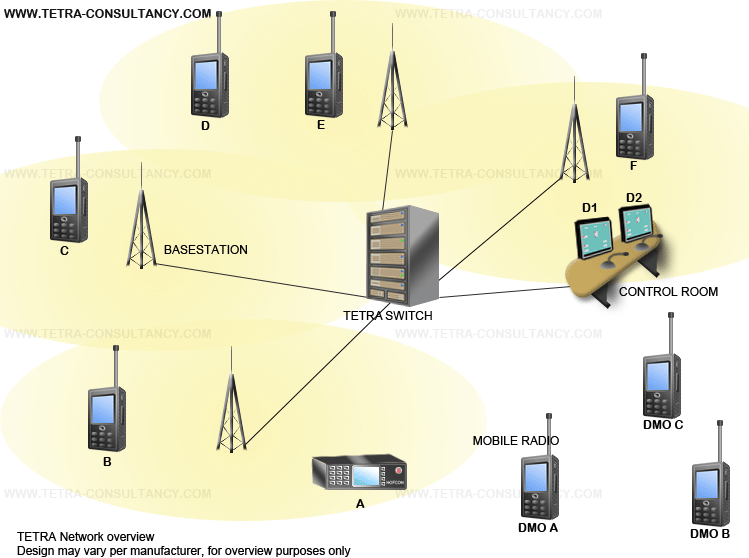TETRA (Terrestial Trunked Radio) is a digital trunked radio standard that is adopted by a variety of manufacturers and is used in for Private Mobile Radio users in Public Safety, Public Transport, Oil and Gas Industry, Military, Airports and more.
TETRA is standardised by the ETSI (The European Telecommunications Standards Institute) and it adopted by a number of manufacturers. The standardisation of TETRA encourages competition and provides makes a wide range of TETRA products possible. Since the TETRA air interface is standardised mobile subscribers from different manufacturers can interoperate with each other and with multi vendor TETRA infrastructure/networks.
Below is a drawing of a basic TETRA network overview. This picture is manufacturer independent and intended for explanation purposes only.

The TETRA network switch
The above picture shows a TETRA network switch that is the central hart of the TETRA network. Depending on the needed network availability most manufacturers can offer a redundant TETRA network switch to is able to take over the network services of a failure in the active switch. When a redundant TETRA network switch is available this is usually at a geographical separated location. Depending on the manufacturer of the TETRA network and required capacity additional TETRA switches are needed to provide the required capacity.
The TETRA network switch basically holds the database with information of the allowed mobile radios and the services assigned to them. Mobile radios are also called subscribers of Mobile Stations (MS). It has knowledge of the configured talkgroups and switches the speech coming to and from the mobile radios. It holds track of the affiliation of the mobile radios to the basestations and assigns the traffic channels of the basestations.
The TETRA basestation
The TETRA basestation sends out the TETRA radio signal delivering coverage and receives the TETRA signals send out by the mobile radios. The TETRA basestation is connected to the TETRA network switch. The depending of the manufacturer design the connection is single or redundant, via landline or via microwave link. Depending on the manufacturer design the basestation are connected with the TETRA switch in a star configuration or in a ring configuration.When the TETRA mobile radio moves it roams from one basestation to the other providing that there is sufficient overlapping coverage.
As the name implies (TETRA Terrestial Trunked Radio) the air interface is trunked. A TETRA carrier is devided into four time slots as specified by the ETSI. The maximum number of carriers for one basestation is eight. This gives a total of (4*8=32) timeslots. Where the first time slot is always used for the control channel. The control channel is used for signalling (for example neighbor cell information). Information is broadcasted using the control channel. Mobile stations listen to the control channel and get informed to go to a traffic channel (which is one the time slots of the basestation) were the mobile station can receive the audio. Vice versa, when the mobile station wants to transmit, the mobile station does a request using the control channel that ask the TETRA infrastructure (SwMi Switched Mobile Infrastructure).
Control room or dispatchers
To communicate with the users in the field that are equipped with a TETRA portable radio (mobile station, mobile radio or subscriber) from one or more fixed positions dispatchers can be added to the TETRA network. A locations with dispatcher(s) is also known as a control room. Generally the control room is the central point in the voice communications. Control rooms are connected to the TETRA network switch using a (redundant)landline. The control rooms generally have priority in voice communication but is depending on the manufacturer implementation or operator configuration.
Standardised interfaces
The TETRA air interface is standardised but not the networkmanagement interface, the basestation interface or the control room interface. These interfaces are manufacturer proprietary interfaces and depending on the manufacturer these interface are most times available for third party developers.
